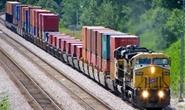Steel Markets

Rail Industry Concerned New Regulations Will Slow Growth
Written by Sandy Williams
October 18, 2014
Rail traffic has increased year-over-year indicating a “resurging economy,” said Edward Hamberger, President and CEO of the Association of American Railroads (AAR), in a speech to the Railway Tie Association.
“An uptick in traffic spells great news for the overall economy and shows it’s headed in a positive direction,” Hamberger said. “We are finally experiencing the comeback we’ve all been waiting for and much of it is riding on our rails.”
But, Hamberger’s optimism was tempered by concern over new government rules and regulations for the rail industry.
Hamberger warned that restrictive regulations would hamper efforts to expand the rail network and buy the necessary equipment to move increased traffic. He noted that the surge in volume has negatively impacted service for some customers.
In the October 11, 2014 report on rail traffic, AAR reported total US rail traffic year-to-date was 22,548,321 carloads and intermodal units, up 4.5 percent from the same period in 2013.
In the week ending October 11, petroleum and petroleum products posted a 19.5 percent increase y/y at 16,333 carloads. Nonmetallic mineral carloads were up 12.2 percent. Total combined rail traffic increased 4.6 percent from the same week in 2013.
The increased traffic has caused service issues around the country. In a recent SMU article, we reported that taconite mills in the upper Midwest were resorting to truck shipments due to the congestion on the rail lines. Part of that congestion was blamed on the increase of petroleum shipments by rail.
Hamberger noted that 15 of the 20 commodities tracked by AAR, including grain and energy, have seen steady increases in year-over-year carload numbers. To meet the increased demand the industry spent more than $25 billion in 2013 on private capital expenditures. The projection for 2014 is $26 billion.
Hamberger warned that proposed regulations will restrict the industry’s ability to grow and service customers.
“The cumulative impact of layers of regulation upon layers of regulation can have a substantial negative impact on service and capacity,” Hamberger said. “We’re caught between the calls for better service and shipper demands for more government regulation.”
“Instead of hampering the rail industry’s ability to grow the nation’s rail network and expand capacity due to the changes brought on by a growing economy, lawmakers and regulators should be applauding the industry’s can-do attitude and commitment. Tying the industry’s hand behind its back is not going to resolve the challenges shippers and rail alike are facing.”
The rail industry has spent $5 billion so far to implement a nationwide Positive Train Control (PTC) system that will strengthen safety measures. The industry will not meet the required deadline for the program due to technical and operational challenges and has asked Congress for an extension.
“The rail industry is committed to boosting both safety and capacity and is today spending more than $2 billion a month upgrading and growing the rail network,” said Hamberger. “We are, indeed, focused on addressing the most acute capacity problems and doing what we must to provide reliable, affordable and efficient service. But for the freight industry to meet demands of our nation’s growing and changing economy, we need to ease the restrictions and regulatory roadblocks that curtail the industry’s ability to relieve service pressures system-wide.”

Sandy Williams
Read more from Sandy WilliamsLatest in Steel Markets

Steel buyer spirits tempered by soft spot market conditions
Steel sheet buyers report feeling bogged down by the ongoing stresses of stagnant demand, news fatigue, tariff negotiations or implementation timelines, and persistent macroeconomic uncertainty.

Hot-rolled coil buyers continue seeking certainty
Steel market participants contend that buyers will remain in “wait-and-see" mode until some market stability is restored.

Latin American steel advocates warn on cheap import flood
Subsidized Chinese steel imports and cheap steel products from Association of Southeast Asian Nations (ASEAN) entering Latin American (LATAM) are threatening the region's steel market.

CRU: Steel prices fall amid global demand weakness
The forceful headwinds bearing down on steel markets across the globe have created demand challenges and sent prices southward. The US, however, challenged the global trend.

Hot-rolled price hikes garner mixed reactions from the market
Several steel market sources say they were blindsided when mills increased spot prices for hot-rolled coils this week.
